Early-Stage Impacts of Irrigated Conservation Agriculture on Soil Physical Properties and Crop Performance in a French Mediterranean System
Abstract
1. Introduction
| Reference | Time of Practice | CA Practices | Climate (Country) | Soil Type (Texture) | Irrigation | Soil Temperature | Bulk Density | Penetration Resistance | Infiltration | Soil Evaporation | Grain Yield | Water Productivity |
|---|---|---|---|---|---|---|---|---|---|---|---|---|
| [24] | 1 year | CA | Semi-arid continental (Spain) | Vertic Luvisol (Loam) | Sprinkler | ↓ fluctuations, ↓ 1.9–2.5 °C | ↑ 12–19% | ↑ 25–33% | ND | ND | ↓ 15.4% | ↓ 15.4% (crop yield/irrigation applied) |
| [45] | 1 year | CA | Sub-tropical (Cuba) | Red Ferralitic | Not irrigated | ND | ↓ 7% | ND | ↑ 20% | ND | ND | ND |
| [18] | 2 years | CA | Sub-tropical (Nepal) | (Silt–Loam) | Not irrigated | ND | ↑ 5% | ND | Soil sorptivity about three times slower | ND | ≈ in the first year, ↓ 72% second year | ND |
| [21] | 2 years | No tillage | Semi-arid (Iran) | (Silty Clay Loam) | Sprinkler | ND | ↑ 6% | ↑ 37% | ND | ND | ↓ 18% | ND |
| [19] | 2 or 5 years | No tillage and cover crop | Semi-arid (Southern Malawi) | Chromic Luvisols and Chromic Cambisols—(Clay Loams to Clay) | Not irrigated | ND | ↑ 5% | ND | ↓ 13% of hydraulic conductivity after 2 years, ≈ after 5 years | ND | ND | ND |
| This study | 3 years | CA | Mediterranean (France) | Fluvisol- (Loam) | Sprinkler, subsurface drip and not irrigated | - | - | - | - | - | - | - |
| [22,23] | 3 years | CA | Mediterranean (Turkey) | Haploxererts (Heavy Clay) | Sprinkler | ND | ↑ 1–12% | ↑ 7–56% | ↓ 20–40% of saturated hydraulic conductivity | ND | ND | ND |
| [11] | 3 years | CA | Mediterranean (Spain) | Xerofluvent, (Loamy Alluvial) | Sprinkler | ND | ↑ 2–6% | ↓ 3–41% | ↑ soil water storage | ND | ↑ 8–24% | ↑ 11–31% |
| [32] | 3 years | No tillage and cover crops | Semi-humid, monsoon (China) | Hepludolls (Clay Loam) | Not irrigated | ↓ 0.5–0.9 °C | ND | ND | ND | ND | ND | ND |
| [46] | 3 years | Permanent beds, permanent beds with short-duration pulse crop | Semi-arid (India) | (Clay Loam) | Flood | ND | ND | ND | ND | ND | ↑ 4.2–13.5% | ↑ 28–40% (grain yield/crop evapotranspiration) |
| [20] | 3 years | CA | Tropical (Ghana) | Ferric Lixisols (Sandy with Low Clay Content) | Not irrigated | ND | ↑ 10–15% | ND | ND | ND | ↓ 23–37% | ND |
| [24] | 3 years | No tillage and cover crop | Sub-humid mediterranean (Chile) | Ultic Palexerals (Sandy Loam and Clay) | Not irrigated | ND | ND | ↑ 25% in the first 20 cm depth | ND | ND | ↓ 29–35% | ND |
| [47] | 3 years | No tillage and cover crop | Sub-humid (Italy) | Fluvi-Calcaric Cambisol (Silty Loam) | Not irrigated | ND | ↑ 6.5% | ↑ 31–36% | ↑ more than twice | ND | ND | ND |
| [25] | 3 to 5 years | No tillage, cover crop (mulch) | Semi-arid (Iran) | Haploxerepts (Silty Clay Loam) | Flood | ND | ↑ 7–11% | ND | ↓ 13% of cumulative water infiltration | ND | ↓ 11–31% | ↑ 8% (crop yield/total water applied) |
| [48] | 3, 6 and 9 years | No tillage and cover crop | Sub-tropical continental monsoon (India) | Alluvium (Sandy Clay Loam and Clay Loam) | Flood | ND | ↑ 7%, 2% and 3% after 3, 6 and 9 years, respectively | ND | ND | ND | ND | ND |
| [33] | 3 and 6 years | No tillage and cover crop | Mediterranean (Spain) | Vertisol | Not irrigated | ↓ of fluctuations | ND | ND | ND | ND | ND | ND |
| [34] | 3 and 9 years | No tillage and cover crops | Mediterranean (Spain) | Stony District Luvisol (Loam) | Sprinkler | ND | ND | ↓ 60% | ↑ 26–44% of soil water content | ND | ND | ND |
| [35] | 3 and 7 years | No tillage and cover crops | Mediterranean (Spain) | Hydragic Anthrosol | Sprinkler and flood | ND | ND | ↑ in the 0–25 cm layer ≈ for deeper layers | ND | ND | ↑ 7–70% for the first 3 years and ↑ 50–170% after 7 years | ↑ 10–70% for the first 3 years ↑ 50–170% after 7 years (grain yield/irrigation water) |
| [49] | 4 years | No tillage, permanent beds, residue retention, crop rotation | Sub-tropical (India) | (Silty Loam) | Flood | ND | ND | ND | ND | ND | ↑ 12–16% for maize and ↑ 5–9% for wheat | ↑ 35–94% (grain yield/irrigation water applied) |
| [36] | 5 to 10 years | CA | Mediterranean (Spain) | Xerofluvent (Sandy Clay Loam) | Not irrigated (winter season) | ND | ND | ↑ 10–15 times | ND | ND | ↓ 97% | ND |
| [28] | 5 to 7 years | No tillage, organic amendments | Moist Mediterranean (Spain) | Clay-Skeletal, Kaolinitic, Acid, Thermic Plinthoc Palexerults | Not irrigated (winter season) | ND | ↓ 12% | ND | ↑ 56–59% of hydraulic conductivity | ND | ↑ 3–4 times | ND |
| [50] | 5 to 8 years | Mulch till and cover crop and crop rotation | Oceanic with both Atlantic and Mediterranean influences (Southwestern France) | Gleyic Luvisol (Loamy, Illuvial Clay and Alluvial Pebbly) | Center pivot | ↓ 0.8–2.8 °C at sowing | ND | ND | ND | ND | ND | ND |
| [51] | 5 to 7 years | CA | Semi-arid (India) | Alluvium (Sandy Clay Loam) | Flood | ↓ 1.3 °C | ND | ND | ND | ND | ↑ 12% | ↑ 15% (grain yield/irrigation applied) |
| [52] | 6 years | No tillage, cover crop and occasional crop rotation | Semi-arid (United States) | Abilene (Clay Loam) | Subsurface drip | ND | ND | ND | ND | ND | ↑ 9% | ↑ 9–11% (grain yield/irrigation applied) |
| [26] | 6 years | CA | Sub-humid and cool temperate (Canada) | Gray Luvisol | Not irrigated | ND | ↑ 9% | ↑ 10–79% | ↓ 33% | ND | ND | ND |
| [31] | 6 years | CA in monocropping and intercropping | Tropical wet and savanna (Malawi) | Ferric/Orthic Acrisol and Ferric Luvisol (Sandy Clay Loam) | Not irrigated | ND | ND | ND | ↑ 18–42% | ND | ↑ 30–133% | ND |
| [53] | 7 years | CA | Semi-arid (India) | Typic Haplustept (Clay Loam) | Flood | ND | ≈ | ↓ 20–41% | ≈ | ND | ↑ 13–21% | ND |
| [27] | 7 years | CA | Semi-arid (India) | Haplustept (Sandy Loam) | Flood | NS | ↓ 4–7% | ↓ 16–27% | ↑ 11–12% | ND | ND | ND |
| [7] | 7 years | No tillage and crop rotation | Mediterranean (Italy) | (Clay Loam) | Not irrigated (winter season) | ↑ 0.3 °C | ND | ND | ND | ND | ND | ND |
| [54] | 7 to 9 years | No tillage, crop rotation | Humid temperate (Argentina) | Argiaquoll (Clay Loam, Clayey, Silty Clay) | Not irrigated | ND | ↑ 5% | ND | ≈ | ND | ND | ND |
| [28] | 8 years | CA | Mediterranean (Spain) | Parexerults (Sandy Loam, Sandy Clay and Sandy Clay Loam) | Not irrigated (winter season) | ND | ↓ 13% | ND | ↑ 120% of mean infiltration ↑ 140% of hydraulic conductivity | ND | ↑ 3 times | ND |
| [41] | 9 to 28 years | No till, strip till, crop rotation | Oceanic (Southwestern France) | Calcisols, Umbrisols and Luvisols | Sprinkler and not irrigated | ND | ND | ND | ↑ 1.5–3 times of mean hydraulic conductivity | ND | ND | ND |
| [55] | 10 years | No tillage and crop rotation | Temperate semi-humid continental monsoon (China) | Dark Loessial Soil (Middle Loam) | Not irrigated | ND | ↓ 7.7% | ND | ND | ND | ≈ | ND |
| [56] | 10–12 years | CA in monocropping and intercropping | Tropical wet and savanna (Malawi) | Chromic Luvisol, Haplic Lixisols (Sandy Clay Loam and Sandy Loam) | Not irrigated | ND | ND | ND | ↑ 44–450% of hydraulic conductivity | ND | ND | ND |
| [57] | 12 years | CA | Humid continental (Canada) | Dystric Gleysol (Loamy Sand) | Not irrigated | ND | ↑ 10% | ND | ≈ | ND | ND | ND |
| [29] | 14 years | CA | Humid sub-tropical (Zambia) | Ferric Lixisols | Not irrigated | ND | ND | ND | ↑ 74% of mean infiltration rates | ND | ↑ 64% | ND |
| [58] | 15 years | No tillage and crop rotation | Semi-arid (India) | (Loam, Sandy Loam and Clay Loam) | Flood | ND | ↑ on the topsoil and ≈ after 10 cm | ND | ↑ 38–51% of saturated hydraulic conductivity ↑ 28% of water intake rate | ND | ≈ | ND |
| [59] | 16 years | CA and differentiated fertilization | Mediterranean (Italy) | Typic Xerofluvent (Loam) | Not irrigated | ND | ↓ 3% in the 0–10 cm layer ↑ 5% in the lower layers | ND | ND | ND | ↓ 17% of total biomass yield | ND |
| [33] | 20 years | No tillage and crop rotation | Mediterranean (Spain) | Vertisol | Not irrigated | ↓ 0.7–2.6 °C | ND | ND | ND | ND | ND | ND |
| [44] | 20 years | No tillage and barley monocropping | Semiarid Mediterranean (Spain) | Xerofluvent | Solid set | ND | ↑ 2–12% | ↑ 17% | ↑ 45% | ND | Slight ↑ | ND |
| [60] | 21 years | No tillage, differentiated fertilization | Humid sub-tropical (USA) | Typic Paleudalf—Maury (Silt Loam) | Not irrigated | ND | ≈ | ND | ND | ND | ≈ | ND |
| [30] | 22 years | CA | Cold semi-arid (Mexico) | Feozem (Sandy Clay Loam) | Flood | ND | ↓ 20% | ↓ 92% | ↑ 95% | ND | ↑ 52% | ND |
| [61] | 26 years | CA | Semiarid Mediterranean (Spain) | Xerofluvent (Silt Loam) | Solid set | ND | ↑ 6% | ND | ↑ 33% | ND | ND | ND |
2. Materials and Methods
2.1. Site Description
2.2. Climatic Data
2.3. Experimental Design
2.4. Farming Practices
2.5. Irrigation
2.6. Soil Monitoring
2.6.1. Soil Temperature
2.6.2. Bulk Density
2.6.3. Soil Penetration Resistance
2.7. Soil Water Flux Monitoring
2.7.1. Soil Infiltration
2.7.2. Soil Evaporation
2.7.3. Surface Soil Water Content
2.8. Crop Monitoring
2.8.1. Leaf Area Index (LAI)
2.8.2. Grain Yield (GY)
2.9. Total Water Productivity and Irrigation Water Productivity
2.10. Dates of Measurement
2.11. Statistical Analysis
3. Results
3.1. Soil Temperature
3.2. Bulk Density
3.3. Soil Penetration Resistance
3.4. Quasi-Steady Ponded Infiltration
3.5. Soil Evaporation
3.6. Leaf Area Index (LAI) and Grain Yield (GY)
3.7. Water Productivity
3.8. Effect of Practice and Irrigation System on Dependent Variables
4. Discussion
4.1. Effects of CA and Irrigation System on Soil Physical Properties
4.1.1. Temperature
4.1.2. Bulk Density
4.1.3. Penetration Resistance
4.2. Effect of CA and Irrigation System on Water Flux
4.2.1. Infiltration
4.2.2. Evaporation
4.3. Effect of CA and Irrigation System on LAI, GY, TWP and IWP
4.4. Challenges of CA Adoption
4.5. Subsurface Drip Irrigation in CA
5. Conclusions
Author Contributions
Funding
Data Availability Statement
Acknowledgments
Conflicts of Interest
Abbreviations
| CA | Conservation Agriculture |
| CT | Conventional Tillage |
| S | Sprinkler |
| SSD | Subsurface Drip |
| NI | No Irrigation |
| GY | Grain Yield |
| LAI | Leaf Area Index |
| TWP | Total Water Productivity |
| IWP | Irrigation Water Productivity |
References
- Morugán-Coronado, A.; Linares, C.; Gómez-López, M.D.; Faz, Á.; Zornoza, R. The Impact of Intercropping, Tillage and Fertilizer Type on Soil and Crop Yield in Fruit Orchards under Mediterranean Conditions: A Meta-Analysis of Field Studies. Agric. Syst. 2020, 178, 102736. [Google Scholar] [CrossRef]
- Ferreira, C.S.S.; Seifollahi-Aghmiuni, S.; Destouni, G.; Ghajarnia, N.; Kalantari, Z. Soil Degradation in the European Mediterranean Region: Processes, Status and Consequences. Sci. Total Environ. 2022, 805, 150106. [Google Scholar] [CrossRef]
- Eaufrance Bulletin N°5: Prélèvements Quantitatifs sur la Ressource en Eau. Available online: https://www.eaufrance.fr/publications/prelevements-quantitatifs-sur-la-ressource-en-eau-donnees-2016 (accessed on 15 November 2024).
- Fader, M.; Shi, S.; von Bloh, W.; Bondeau, A.; Cramer, W. Mediterranean Irrigation under Climate Change: More Efficient Irrigation Needed to Compensate for Increases in Irrigation Water Requirements. Hydrol. Earth Syst. Sci. 2016, 20, 953–973. [Google Scholar] [CrossRef]
- Galeotti, M. The Economic Impacts of Climate Change in the Mediterranean. In IEMed Mediterranean Yearbook; IEMed: Barcelona, Spain, 2020. [Google Scholar]
- Busari, M.A.; Kukal, S.S.; Kaur, A.; Bhatt, R.; Dulazi, A.A. Conservation Tillage Impacts on Soil, Crop and the Environment. Int. Soil Water Conserv. Res. 2015, 3, 119–129. [Google Scholar] [CrossRef]
- Stagnari, F.; Pagnani, G.; Galieni, A.; D’Egidio, S.; Matteucci, F.; Pisante, M. Effects of Conservation Agriculture Practices on Soil Quality Indicators: A Case-Study in a Wheat-Based Cropping Systems of Mediterranean Areas. Soil Sci. Plant Nutr. 2020, 66, 624–635. [Google Scholar] [CrossRef]
- FAO Conservation Agriculture. Available online: https://www.fao.org/conservation-agriculture/en/ (accessed on 6 June 2024).
- Jat, R.K.; Sapkota, T.B.; Singh, R.G.; Jat, M.L.; Kumar, M.; Gupta, R.K. Seven Years of Conservation Agriculture in a Rice-Wheat Rotation of Eastern Gangetic Plains of South Asia: Yield Trends and Economic Profitability. Field Crops Res. 2014, 164, 199–210. [Google Scholar] [CrossRef]
- Page, K.L.; Dang, Y.P.; Dalal, R.C. The Ability of Conservation Agriculture to Conserve Soil Organic Carbon and the Subsequent Impact on Soil Physical, Chemical, and Biological Properties and Yield. Front. Sustain. Food Syst. 2020, 4, 31. [Google Scholar] [CrossRef]
- Boulal, H.; Gómez-Macpherson, H.; Villalobos, F.J. Permanent Bed Planting in Irrigated Mediterranean Conditions: Short-Term Effects on Soil Quality, Crop Yield and Water Use Efficiency. Field Crops Res. 2012, 130, 120–127. [Google Scholar] [CrossRef]
- Kassam, A.; Friedrich, T.; Derpsch, R.; Lahmar, R.; Mrabet, R.; Basch, G.; González-Sánchez, E.J.; Serraj, R. Conservation Agriculture in the Dry Mediterranean Climate. Field Crops Res. 2012, 132, 7–17. [Google Scholar] [CrossRef]
- Ghaley, B.B.; Rusu, T.; Sandén, T.; Spiegel, H.; Menta, C.; Visioli, G.; O’Sullivan, L.; Gattin, I.T.; Delgado, A.; Liebig, M.A.; et al. Assessment of Benefits of Conservation Agriculture on Soil Functions in Arable Production Systems in Europe. Sustainability 2018, 10, 794. [Google Scholar] [CrossRef]
- Lee, H.; Lautenbach, S.; García-Nieto, A.P.; Bondeau, A.; Cramer, W.; Geijzendorffer, I.; García-Nieto, A. The Impact of Conservation Farming Practices on Mediterranean Agro-Ecosystem Services Provisioning-a Meta-Analysis. Reg. Environ. Change 2019, 19, 2187–2202. [Google Scholar] [CrossRef]
- Mastrorilli, M.; Zucaro, R. Towards Sustainable Use of Water in Rainfed and Irrigated Cropping Systems: Review of Some Technical and Policy Issues. AIMS Agric. Food 2016, 1, 294–314. [Google Scholar] [CrossRef]
- Giller, K.E.; Witter, E.; Corbeels, M.; Tittonell, P. Conservation Agriculture and Smallholder Farming in Africa: The Heretics’ View. Field Crops Res. 2009, 114, 23–34. [Google Scholar] [CrossRef]
- Salem, H.M.; Valero, C.; Muñoz, M.Á.; Rodríguez, M.G.; Silva, L.L. Short-Term Effects of Four Tillage Practices on Soil Physical Properties, Soil Water Potential, and Maize Yield. Geoderma 2015, 237–238, 60–70. [Google Scholar] [CrossRef]
- Laborde, J.P.; Wortmann, C.S.; Blanco-Canqui, H.; McDonald, A.J.; Baigorria, G.A.; Lindquist, J.L. Short-Term Impacts of Conservation Agriculture on Soil Physical Properties and Productivity in the Midhills of Nepal. Agron. J. 2019, 111, 2128–2139. [Google Scholar] [CrossRef]
- Mloza-Banda, H.R.; Makwiza, C.N.; Mloza-Banda, M.L. Soil Properties after Conversion to Conservation Agriculture from Ridge Tillage in Southern Malawi. J. Arid. Environ. 2016, 127, 7–16. [Google Scholar] [CrossRef]
- Naab, J.B.; Mahama, G.Y.; Yahaya, I.; Prasad, P.V.V. Conservation Agriculture Improves Soil Quality, Crop Yield, and Incomes of Smallholder Farmers in North Western Ghana. Front. Plant Sci. 2017, 8, 996. [Google Scholar] [CrossRef] [PubMed]
- Afzalinia, S.; Zabihi, J. Soil Compaction Variation during Corn Growing Season under Conservation Tillage. Soil Tillage Res. 2014, 137, 1–6. [Google Scholar] [CrossRef]
- Celik, I. Effects of Tillage Methods on Penetration Resistance, Bulk Density and Saturated Hydraulic Conductivity in a Clayey Soil Conditions. Tarim Bilimleri Dergisi 2011, 17, 143–156. [Google Scholar]
- Celik, I.; Turgut, M.M.; Acir, N. Crop Rotation and Tillage Effects on Selected Soil Physical Properties of a Typic Haploxerert in an Irrigated Semi-Arid Mediterranean Region. Int. J. Plant Prod. 2012, 6, 157–480. [Google Scholar]
- Martínez, I.; Ovalle, C.; Del Pozo, A.; Uribe, H.; Natalia Valderrama, V.; Prat, C.; Sandoval, M.; Fernández, F.; Zagal, E. Influence of Conservation Tillage and Soil Water Content on Crop Yield in Dryland Compacted Alfisol of Central Chile. Chil. J. Agric. Res. 2011, 71, 615–622. [Google Scholar] [CrossRef]
- Khorami, S.S.; Kazemeini, S.A.; Afzalinia, S.; Gathala, M.K. Changes in Soil Properties and Productivity under Different Tillage Practices and Wheat Genotypes: A Short-Term Study in Iran. Sustainability 2018, 10, 3273. [Google Scholar] [CrossRef]
- Singh, B.; Malhi, S.S. Response of Soil Physical Properties to Tillage and Residue Management on Two Soils in a Cool Temperate Environment. Soil Tillage Res. 2006, 85, 143–153. [Google Scholar] [CrossRef]
- Parihar, C.M.; Yadav, M.R.; Jat, S.L.; Singh, A.K.; Kumar, B.; Pradhan, S.; Chakraborty, D.; Jat, M.L.; Jat, R.K.; Saharawat, Y.S.; et al. Long Term Effect of Conservation Agriculture in Maize Rotations on Total Organic Carbon, Physical and Biological Properties of a Sandy Loam Soil in North-Western Indo-Gangetic Plains. Soil Tillage Res. 2016, 161, 116–128. [Google Scholar] [CrossRef]
- Gómez-Paccard, C.; Hontoria, C.; Mariscal-Sancho, I.; Pérez, J.; León, P.; González, P.; Espejo, R. Soil–Water Relationships in the Upper Soil Layer in a Mediterranean Palexerult as Affected by No-Tillage under Excess Water Conditions—Influence on Crop Yield. Soil Tillage Res. 2015, 146, 303–312. [Google Scholar] [CrossRef]
- Mhlanga, B.; Thierfelder, C. Long-Term Conservation Agriculture Improves Water Properties and Crop Productivity in a Lixisol. Geoderma 2021, 398, 115107. [Google Scholar] [CrossRef]
- Martínez, M.; Salvador, E.; Ceja, O.; Espinosa Ramírez, M. Accumulated Impact of Conservation Agriculture on Soil Properties and Corn Yield; Instituto Nacional de Investigaciones Forestales, Agrícolas y Pecuarias (INIFAP): Mexico City, Mexico, 2019; Volume 10. [Google Scholar]
- Ngwira, A.R.; Thierfelder, C.; Lambert, D.M. Conservation Agriculture Systems for Malawian Smallholder Farmers: Long-Term Effects on Crop Productivity, Profitability and Soil Quality. Renew. Agric. Food Syst. 2013, 28, 350–363. [Google Scholar] [CrossRef]
- Shen, Y.; McLaughlin, N.; Zhang, X.; Xu, M.; Liang, A. Effect of Tillage and Crop Residue on Soil Temperature Following Planting for a Black Soil in Northeast China. Sci. Rep. 2018, 8, 4500. [Google Scholar] [CrossRef]
- Muñoz, V.; Lopez, L.; Lopez, R. Effect of Tillage System on Soil Temperature in a Rainfed Mediterranean Vertisol. Int. Agrophys. 2015, 29, 467–473. [Google Scholar] [CrossRef]
- Muñoz, A.; López-Piñeiro, A.; Ramírez, M. Soil Quality Attributes of Conservation Management Regimes in a Semi-Arid Region of South Western Spain. Soil Tillage Res. 2007, 95, 255–265. [Google Scholar] [CrossRef]
- Sánchez-Llerena, J.; López-Piñeiro, A.; Albarrán, Á.; Peña, D.; Becerra, D.; Rato-Nunes, J.M. Short and Long-Term Effects of Different Irrigation and Tillage Systems on Soil Properties and Rice Productivity under Mediterranean Conditions. Eur. J. Agron. 2016, 77, 101–110. [Google Scholar] [CrossRef]
- López-Garrido, R.; Madejón, E.; León-Camacho, M.; Girón, I.; Moreno, F.; Murillo, J.M. Reduced Tillage as an Alternative to No-Tillage under Mediterranean Conditions: A Case Study. Soil Tillage Res. 2014, 140, 40–47. [Google Scholar] [CrossRef]
- Gabriel, J.L.; Muñoz-Carpena, R.; Quemada, M. The Role of Cover Crops in Irrigated Systems: Water Balance, Nitrate Leaching and Soil Mineral Nitrogen Accumulation. Agric. Ecosyst. Environ. 2012, 155, 50–61. [Google Scholar] [CrossRef]
- Aguilera, E.; Lassaletta, L.; Gattinger, A.; Gimeno, B. Managing Soil Carbon for Climate Change Mitigation and Adaptation in Mediterranean Cropping Systems: A Meta-Analysis. Agric. Ecosyst. Environ. 2013, 168, 25–36. [Google Scholar] [CrossRef]
- Francaviglia, R.; Di Bene, C.; Farina, R.; Salvati, L. Soil Organic Carbon Sequestration and Tillage Systems in the Mediterranean Basin: A Data Mining Approach. Nutr. Cycl. Agroecosyst. 2017, 107, 125–137. [Google Scholar] [CrossRef]
- Vastola, A.; Zdruli, P.; D’Amico, M.; Pappalardo, G.; Viccaro, M.; Di Napoli, F.; Cozzi, M.; Romano, S. A Comparative Multidimensional Evaluation of Conservation Agriculture Systems: A Case Study from a Mediterranean Area of Southern Italy. Land. Use Policy 2017, 68, 326–333. [Google Scholar] [CrossRef]
- Alletto, L.; Cueff, S.; Bréchemier, J.; Lachaussée, M.; Derrouch, D.; Page, A.; Gleizes, B.; Perrin, P.; Bustillo, V. Physical Properties of Soils under Conservation Agriculture: A Multi-Site Experiment on Five Soil Types in South-Western France. Geoderma 2022, 428, 116228. [Google Scholar] [CrossRef]
- Blanco-Canqui, H.; Ruis, S.J. No-Tillage and Soil Physical Environment. Geoderma 2018, 326, 164–200. [Google Scholar] [CrossRef]
- Panettieri, M.; Carmona, I.; Melero, S.; Madejón, E.; Gómez-Macpherson, H. Effect of Permanent Bed Planting Combined with Controlled Traffic on Soil Chemical and Biochemical Properties in Irrigated Semi-Arid Mediterranean Conditions. Catena 2013, 107, 103–109. [Google Scholar] [CrossRef]
- Pareja-Sánchez, E.; Plaza-Bonilla, D.; Ramos, M.C.; Lampurlanés, J.; Álvaro-Fuentes, J.; Cantero-Martínez, C. Long-Term No-till as a Means to Maintain Soil Surface Structure in an Agroecosystem Transformed into Irrigation. Soil Tillage Res. 2017, 174, 221–230. [Google Scholar] [CrossRef]
- Rodríguez González, A.; Arcia Porrúa, J.; Antonio Martínez Cañizares, J.; Domínguez Vento, C.; Herrera Puebla, J.; Miranda Caballero, A.; González, R. Influence of Conservation Agriculture on Some Physical Properties of a Red Ferra-Litic Soil. Int. J. Food Sci. Agric. 2022, 2022, 320–326. [Google Scholar] [CrossRef]
- Jat, R.D.; Jat, H.S.; Nanwal, R.K.; Yadav, A.K.; Bana, A.; Choudhary, K.M.; Kakraliya, S.K.; Sutaliya, J.M.; Sapkota, T.B.; Jat, M.L. Conservation Agriculture and Precision Nutrient Management Practices in Maize-Wheat System: Effects on Crop and Water Productivity and Economic Profitability. Field Crops Res. 2018, 222, 111–120. [Google Scholar] [CrossRef]
- Sartori, F.; Piccoli, I.; Polese, R.; Berti, A. Transition to Conservation Agriculture: How Tillage Intensity and Covering Affect Soil Physical Parameters. Soil 2022, 8, 213–222. [Google Scholar] [CrossRef]
- Bhattacharya, P.; Maity, P.P.; Mowrer, J.; Maity, A.; Ray, M.; Das, S.; Chakrabarti, B.; Ghosh, T.; Krishnan, P. Assessment of Soil Health Parameters and Application of the Sustainability Index to Fields under Conservation Agriculture for 3, 6, and 9 Years in India. Heliyon 2020, 6, e05640. [Google Scholar] [CrossRef] [PubMed]
- Jat, H.S.; Kumar, V.; Datta, A.; Choudhary, M.; Yadvinder-Singh; Kakraliya, S.K.; Poonia, T.; McDonald, A.J.; Jat, M.L.; Sharma, P.C. Designing Profitable, Resource Use Efficient and Environmentally Sound Cereal Based Systems for the Western Indo-Gangetic Plains. Sci. Rep. 2020, 10, 19267. [Google Scholar] [CrossRef] [PubMed]
- Alletto, L.; Coquet, Y.; Justes, E. Effects of Tillage and Fallow Period Management on Soil Physical Behaviour and Maize Development. Agric. Water Manag. 2011, 102, 74–85. [Google Scholar] [CrossRef]
- Meena, R.; Vashisth, A.; Das, T.K. Effect of Conservation Agriculture on Soil Hydrothermal Regimes, Crop Evapo-Transpiration and Water Productivity of Wheat Crop in the Semi-Arid Region of North-Western India. J. Soil Water Conserv. 2021, 20, 424–430. [Google Scholar] [CrossRef]
- DeLaune, P.B.; Mubvumba, P.; Ale, S.; Kimura, E. Impact of No-till, Cover Crop, and Irrigation on Cotton Yield. Agric. Water Manag. 2020, 232, 106038. [Google Scholar] [CrossRef]
- Mondal, S.; Chakraborty, D.; Das, T.K.; Shrivastava, M.; Mishra, A.K.; Bandyopadhyay, K.K.; Aggarwal, P.; Chaudhari, S.K. Conservation Agriculture Had a Strong Impact on the Sub-Surface Soil Strength and Root Growth in Wheat after a 7-Year Transition Period. Soil Tillage Res. 2019, 195, 104385. [Google Scholar] [CrossRef]
- Sokolowski, A.C.; Prack McCormick, B.; De Grazia, J.; Wolski, J.E.; Rodríguez, H.A.; Rodríguez-Frers, E.P.; Gagey, M.C.; Debelis, S.P.; Paladino, I.R.; Barrios, M.B. Tillage and No-Tillage Effects on Physical and Chemical Properties of an Argiaquoll Soil under Long-Term Crop Rotation in Buenos Aires, Argentina. Int. Soil. Water Conserv. Res. 2020, 8, 185–194. [Google Scholar] [CrossRef]
- Zhang, Y.; Tan, C.; Wang, R.; Li, J.; Wang, X. Conservation Tillage Rotation Enhanced Soil Structure and Soil Nutrients in Long-Term Dryland Agriculture. Eur. J. Agron. 2021, 131, 126379. [Google Scholar] [CrossRef]
- Eze, S.; Dougill, A.J.; Banwart, S.A.; Hermans, T.D.G.; Ligowe, I.S.; Thierfelder, C. Impacts of Conservation Agriculture on Soil Structure and Hydraulic Properties of Malawian Agricultural Systems. Soil Tillage Res. 2020, 201, 104639. [Google Scholar] [CrossRef] [PubMed]
- Dam, R.F.; Mehdi, B.B.; Burgess, M.S.E.; Madramootoo, C.A.; Mehuys, G.R.; Callum, I.R. Soil Bulk Density and Crop Yield under Eleven Consecutive Years of Corn with Different Tillage and Residue Practices in a Sandy Loam Soil in Central Canada. Soil Tillage Res. 2005, 84, 41–53. [Google Scholar] [CrossRef]
- Singh, A.; Phogat, V.K.; Dahiya, R.; Batra, S.D. Impact of Long-Term Zero till Wheat on Soil Physical Properties and Wheat Productivity under Rice–Wheat Cropping System. Soil Tillage Res. 2014, 140, 98–105. [Google Scholar] [CrossRef]
- Mazzoncini, M.; Sapkota, T.B.; Bàrberi, P.; Antichi, D.; Risaliti, R. Long-Term Effect of Tillage, Nitrogen Fertilization and Cover Crops on Soil Organic Carbon and Total Nitrogen Content. Soil Tillage Res. 2011, 114, 165–174. [Google Scholar] [CrossRef]
- Ismail, I.; Blevins, R.L.; Frye, W.W. Long-Term No-Tillage Effects on Soil Properties and Continuous Corn Yields. Soil Sci. Soc. Am. J. 1994, 58, 193–198. [Google Scholar] [CrossRef]
- Talukder, R.; Plaza-Bonilla, D.; Cantero-Martínez, C.; Di Prima, S.; Lampurlanés, J. Spatio-Temporal Variation of Surface Soil Hydraulic Properties under Different Tillage and Maize-Based Crop Sequences in a Mediterranean Area. Plant Soil 2024, 500, 263–277. [Google Scholar] [CrossRef]
- IUSS Working Group WRB International Soil Classification System for Naming Soils and Creating Legends for Soil Maps. World Soil. Resour. Rep. 2015, 106, 166–168.
- Albasha, R.; Thiesson, J.; Buvat, S.; Lopez, J.M.; Cheviron, B. Prospection Géophysique Dans Le Cadre d’une Étude de La Variabilité Spatiale Des Rendements Agricoles. In Proceedings of the GEOFCAN, Orsay, France, 13–14 November 2014; UMR GEOPS: Orsay, France, 2014. [Google Scholar]
- Eijkelkamp, R. Hand-Penetrometer for Top Layers, Type IB Meet the Difference Operating Instructions; Royal Eijkelkamp: Giesbeek, The Netherlands, 2022. [Google Scholar]
- Yolcubal, I.; Brusseau, M.L.; Artiola, J.F.; Wierenga, P.J.; Wilson, L.G. Environmental physical properties and processes. Environ. Monit. Charact. 2004, 207–239. [Google Scholar] [CrossRef]
- Garnier, F.; Elamri, Y. Le Cahier des Techniques de l’INRA 2014 (83) n°3 Automatisation du Dispositif de Müntz Pour la Détermination In Situ de la Conductivité Hydraulique à Saturation, 84th ed.; 2014; Volume 83, 12p, hal-04632381. [Google Scholar]
- Vinatier, F.; Rudi, G.; Coulouma, G.; Dagès, C.; Bailly, J.-S. Dynamics of Quasi-Steady Ponded Infiltration under Contrasting Plant Cover and Management Strategies. Soil Tillage Res. 2024, 237, 105985. [Google Scholar] [CrossRef]
- Bhatt, R.; Singh, P. Evaporation Trends on Intervening Period for Different Wheat Establishments under Soils of Semi-Arid Tropics. J. Soil Water Conserv. 2018, 17, 41. [Google Scholar] [CrossRef]
- Trambouze, W. Caractérisation et Eléments de Modelisation de L’évapotranspiration Réelle de la Vigne à L’échelle de la Parcelle; Ecole Nationale Supérieure Agronomique de Montpellier: Montpellier, France, 1996. [Google Scholar]
- Flumignan, D.L.; de Faria, R.T.; Lena, B.P. Test of a Microlysimeter for Measurement of Soil Evaporation. Eng. Agrícola 2012, 32, 80–90. [Google Scholar] [CrossRef]
- Fang, H.; Liang, S. Leaf Area Index Models. In Encyclopedia of Ecology; Elsevier: Oxford, UK, 2014. [Google Scholar] [CrossRef]
- LI-COR LAI-2200C Plant Canopy Analyzer. Available online: https://www.licor.com/env/products/leaf-area/LAI-2200C/ (accessed on 15 November 2024).
- Shaheen, T.; Riaz, M.S.; Zafar, Y. Soybean Production and Drought Stress. In Abiotic and Biotic Stresses in Soybean Production; Academic Press: San Diego, CA, USA, 2016; pp. 177–196. [Google Scholar] [CrossRef]
- Mailhol, J.C.; Ruelle, P.; Walser, S.; Schütze, N.; Dejean, C. Analysis of AET and Yield Predictions under Surface and Buried Drip Irrigation Systems Using the Crop Model PILOTE and Hydrus-2D. Agric Water Manag. 2011, 98, 1033–1044. [Google Scholar] [CrossRef]
- Bussière, F.; Cellier, P. Modification of the Soil Temperature and Water Content Regimes by a Crop Residue Mulch: Experiment and Modelling. Agric. For. Meteorol. 1994, 68, 1–28. [Google Scholar] [CrossRef]
- Wang, D.; Shannon, M.C.; Grieve, C.M.; Yates, S.R. Soil Water and Temperature Regimes in Drip and Sprinkler Irrigation, and Implications to Soybean Emergence. Agric. Water Manag. 2000, 43, 15–28. [Google Scholar] [CrossRef]
- Abu-Hamdeh, N.H. SW—Soil and Water: Measurement of the Thermal Conductivity of Sandy Loam and Clay Loam Soils Using Single and Dual Probes. J. Agric. Eng. Res. 2001, 80, 209–216. [Google Scholar] [CrossRef]
- Sándor, R.; Fodor, N. Simulation of Soil Temperature Dynamics with Models Using Different Concepts. Sci. World J. 2012, 2012, 590287. [Google Scholar] [CrossRef]
- Kassam, A.; Friedrich, T.; Shaxson, F.; Pretty, J. The Spread of Conservation Agriculture: Justification, Sustainability and Uptake. Int. J. Agric. Sustain. 2009, 7, 292–320. [Google Scholar] [CrossRef]
- Özdemir, N.; Demir, Z.; Bülbül, E. Relationships between Some Soil Properties and Bulk Density under Different Land Use. Soil Stud. 2022, 11, 43–50. [Google Scholar] [CrossRef]
- Rahimi, A.A.; Sepaskhah, A.R.; Ahmadi, S.H. Evaluation of Different Methods for the Prediction of Saturated Hydraulic Conductivity in Tilled and Untilled Soils. Arch. Agron. Soil Sci. 2011, 57, 899–914. [Google Scholar] [CrossRef]
- Nyeki, A.; Milics, G.; Kovacs, A.J.; Neményi, M. Effects of Soil Compaction on Cereal Yield: A Review. Cereal Res. Commun. 2017, 45, 1–22. [Google Scholar] [CrossRef]
- Zhou, H.; LÜ, Y.; YANG, Z.; LI, B. Influence of Conservation Tillage on Soil Aggregates Features in North China Plain. Agric. Sci. China 2007, 6, 1099–1106. [Google Scholar] [CrossRef]
- Taser, O.; Metinoglu, F. Physical and Mechanical Properties of a Clayey Soil as Affected by Tillage Systems for Wheat Growth. Acta Agric. Scand. Sect. B-Soil Plant Sci. 2007, 55, 186–191. [Google Scholar] [CrossRef]
- Indoria, A.K.; Sharma, K.L.; Reddy, K.S. Hydraulic Properties of Soil under Warming Climate. In Climate Change and Soil Interactions; Elsevier: Amsterdam, The Netherlands, 2020; Chapter 18; pp. 473–508. [Google Scholar] [CrossRef]
- Souza, R.; Hartzell, S.; Freire Ferraz, A.P.; de Almeida, A.Q.; de Sousa Lima, J.R.; Dantas Antonino, A.C.; de Souza, E.S. Dynamics of Soil Penetration Resistance in Water-Controlled Environments. Soil Tillage Res. 2021, 205, 104768. [Google Scholar] [CrossRef]
- Hamza, M.A.; Anderson, W.K. Soil Compaction in Cropping Systems: A Review of the Nature, Causes and Possible Solutions. Soil Tillage Res. 2005, 82, 121–145. [Google Scholar] [CrossRef]
- Aase, J.K.; Bjorneberg, D.L.; Sojka, R.E. Zone-Subsoiling Relationships to Bulk Density and Cone Index on a Furrow-Irrigated Soil. Trans. Am. Soc. Agric. Eng. 2001, 44, 577. [Google Scholar] [CrossRef][Green Version]
- Jeřábek, J.; Zumr, D.; Dostál, T. Identifying the Plough Pan Position on Cultivated Soils by Measurements of Electrical Resistivity and Penetration Resistance. Soil Tillage Res. 2017, 174, 231–240. [Google Scholar] [CrossRef]
- Peigné, J.; Vian, J.-F.; Payet, V.; Saby, N.P.A. Soil Fertility after 10 Years of Conservation Tillage in Organic Farming. Soil Tillage Res. 2018, 175, 194–204. [Google Scholar] [CrossRef]
- da Silva, V.R.; Reinert, D.J.; Reichert, J.M. Resistência Mecânica Do Solo à Penetração Influenciada Pelo Tráfego de Uma Colhedora Em Dois Sistemas de Manejo Do Solo. Ciência Rural 2000, 30, 795–801. [Google Scholar] [CrossRef]
- Lamm, F.R. Managing the Challenges of Subsurface Drip Irrigation. In Proceedings of the Irrigation Association Technical Conference, San Antonio, TX, USA, 2–5 December 2009. [Google Scholar]
- Materechera, S.A.; Mloza-Banda, H.R. Soil Penetration Resistance, Root Growth and Yield of Maize as Influenced by Tillage System on Ridges in Malawi. Soil Tillage Res. 1997, 41, 13–24. [Google Scholar] [CrossRef]
- Coulouma, G.; Boizard, H.; Trotoux, G.; Lagacherie, P.; Richard, G. Effect of Deep Tillage for Vineyard Establishment on Soil Structure: A Case Study in Southern France. Soil Tillage Res. 2006, 88, 132–143. [Google Scholar] [CrossRef]
- Mubarak, I.; Mailhol, J.C.; Angulo-Jaramillo, R.; Ruelle, P.; Boivin, P.; Khaledian, M. Temporal Variability in Soil Hydraulic Properties under Drip Irrigation. Geoderma 2009, 150, 158–165. [Google Scholar] [CrossRef]
- Horn, R.; Way, T.; Rostek, J. Effect of Repeated Tractor Wheeling on Stress/Strain Properties and Consequences on Physical Properties in Structured Arable Soils. Soil Tillage Res. 2003, 73, 101–106. [Google Scholar] [CrossRef]
- Esser, K.B. Water Infiltration and Moisture in Soils under Conservation and Conventional Agriculture in Agro-Ecological Zone IIa, Zambia. Agronomy 2017, 7, 40. [Google Scholar] [CrossRef]
- Roua, A.; Ibrahimi, K.; Sher, F.; Milham, P.; Ghazouani, H.; Chehaibi, S.; Hussain, Z.; Iqbal, H. Impacts of Different Tillage Practices on Soil Water Infiltration for Sustainable Agriculture. Sustainability 2021, 13, 3155. [Google Scholar] [CrossRef]
- Azooz, R.H.; Arshad, M.A. Soil Infiltration and Hydraulic Conductivity under Long-Term No-Tillage and Conventional Tillage Systems. Can. J. Soil Sci. 1996, 76, 143–152. [Google Scholar] [CrossRef]
- Lipiec, J.; Kuś, J.; Słowińska-Jurkiewicz, A.; Nosalewicz, A. Soil Porosity and Water Infiltration as Influenced by Tillage Methods. Soil Tillage Res. 2006, 89, 210–220. [Google Scholar] [CrossRef]
- Thierfelder, C.; Wall, P.C. Effects of Conservation Agriculture Techniques on Infiltration and Soil Water Content in Zambia and Zimbabwe. Soil Tillage Res. 2009, 105, 217–227. [Google Scholar] [CrossRef]
- Van Donk, S.J.; Martin, D.L.; Irmak, S.; Melvin, S.R.; Petersen, J.L.; Davison, D.R. Crop Residue Cover Effects on Evaporation, Soil Water Content, and Yield of Deficit-Irrigated Corn in West-Central Nebraska. Trans. ASABE 2010, 53, 1787–1797. [Google Scholar] [CrossRef]
- Horton, R.; Bristow, K.L.; Kluitenberg, G.J.; Sauer, T.J. Crop Residue Effects on Surface Radiation and Energy Balance—Review. Theor. Appl. Clim. 1996, 54, 27–37. [Google Scholar] [CrossRef]
- Fuchs, M.; Hadas, A. Mulch Resistance to Water Vapor Transport. Agric. Water Manag. 2011, 98, 990–998. [Google Scholar] [CrossRef]
- Baalousha, H.M.; Ramasomanana, F.; Fahs, M.; Seers, T.D. Measuring and Validating the Actual Evaporation and Soil Moisture Dynamic in Arid Regions under Unirrigated Land Using Smart Field Lysimeters and Numerical Modeling. Water 2022, 14, 2787. [Google Scholar] [CrossRef]
- Chen, Y.; Cavers, C.; Tessier, S.; Monero, F.; Lobb, D. Short-Term Tillage Effects on Soil Cone Index and Plant Development in a Poorly Drained, Heavy Clay Soil. Soil Tillage Res. 2005, 82, 161–171. [Google Scholar] [CrossRef]
- Cárceles Rodríguez, B.; Durán-Zuazo, V.H.; Soriano Rodríguez, M.; García-Tejero, I.F.; Gálvez Ruiz, B.; Cuadros Tavira, S. Conservation Agriculture as a Sustainable System for Soil Health: A Review. Soil Syst. 2022, 6, 87. [Google Scholar] [CrossRef]
- Van den Putte, A.; Govers, G.; Diels, J.; Gillijns, K.; Demuzere, M. Assessing the Effect of Soil Tillage on Crop Growth: A Meta-Regression Analysis on European Crop Yields under Conservation Agriculture. Eur. J. Agron. 2010, 33, 231–241. [Google Scholar] [CrossRef]
- Rana, B.; Parihar, C.M.; Jat, M.L.; Patra, K.; Nayak, H.S.; Reddy, K.S.; Sarkar, A.; Anand, A.; Naguib, W.; Gupta, N.; et al. Combining Sub-Surface Fertigation with Conservation Agriculture in Intensively Irrigated Rice under Rice-Wheat System Can Be an Option for Sustainably Improving Water and Nitrogen Use-Efficiency. Field Crops Res. 2023, 302, 109074. [Google Scholar] [CrossRef]
- Martínez Gamiño, M.Á.; Osuna Ceja, E.S.; Espinosa Ramírez, M.; Martínez-Gamiño, M.Á.; Osuna Ceja, E.S.; Espinosa Ramírez, M. Impacto Acumulado de La Agricultura de Conservación En Propiedades Del Suelo y Rendimiento de Maíz. Rev. Mex. Cienc. Agric. 2019, 10, 765–778. [Google Scholar] [CrossRef]
- Abdallah, A.M.; Jat, H.S.; Choudhary, M.; Abdelaty, E.F.; Sharma, P.C.; Jat, M.L. Conservation Agriculture Effects on Soil Water Holding Capacity and Water-Saving Varied with Management Practices and Agroecological Conditions: A Review. Agronomy 2021, 11, 1681. [Google Scholar] [CrossRef]
- Serra-Wittling, C.; Molle, B.; Cheviron, B. Plot Level Assessment of Irrigation Water Savings Due to the Shift from Sprinkler to Localized Irrigation Systems or to the Use of Soil Hydric Status Probes. Application in the French Context. Agric. Water Manag. 2019, 223, 105682. [Google Scholar] [CrossRef]
- Umair, M.; Hussain, T.; Jiang, H.; Ahmad, A.; Yao, J.; Qi, Y.; Zhang, Y.; Min, L.; Shen, Y. Water-Saving Potential of Subsurface Drip Irrigation for Winter Wheat. Sustainability 2019, 11, 2978. [Google Scholar] [CrossRef]
- Jacobsen, S.E.; Jensen, C.R.; Liu, F. Improving Crop Production in the Arid Mediterranean Climate. Field Crops Res. 2012, 128, 34–47. [Google Scholar] [CrossRef]
- Sidhu, H.S.; Jat, M.L.; Singh, Y.; Sidhu, R.K.; Gupta, N.; Singh, P.; Singh, P.; Jat, H.S.; Gerard, B. Sub-Surface Drip Fertigation with Conservation Agriculture in a Rice-Wheat System: A Breakthrough for Addressing Water and Nitrogen Use Efficiency. Agric. Water Manag. 2019, 216, 273–283. [Google Scholar] [CrossRef]
- Cakir, R. Effect of Water Stress at Different Development Stages on Vegetative and Reproductive Growth of Corn. Field Crops Res. 2004, 89, 1–16. [Google Scholar] [CrossRef]
- Wang, H.; Wang, N.; Quan, H.; Zhang, F.; Fan, J.; Feng, H.; Cheng, M.; Liao, Z.; Wang, X.; Xiang, Y. Yield and Water Productivity of Crops, Vegetables and Fruits under Subsurface Drip Irrigation: A Global Meta-Analysis. Agric. Water Manag. 2022, 269, 107645. [Google Scholar] [CrossRef]
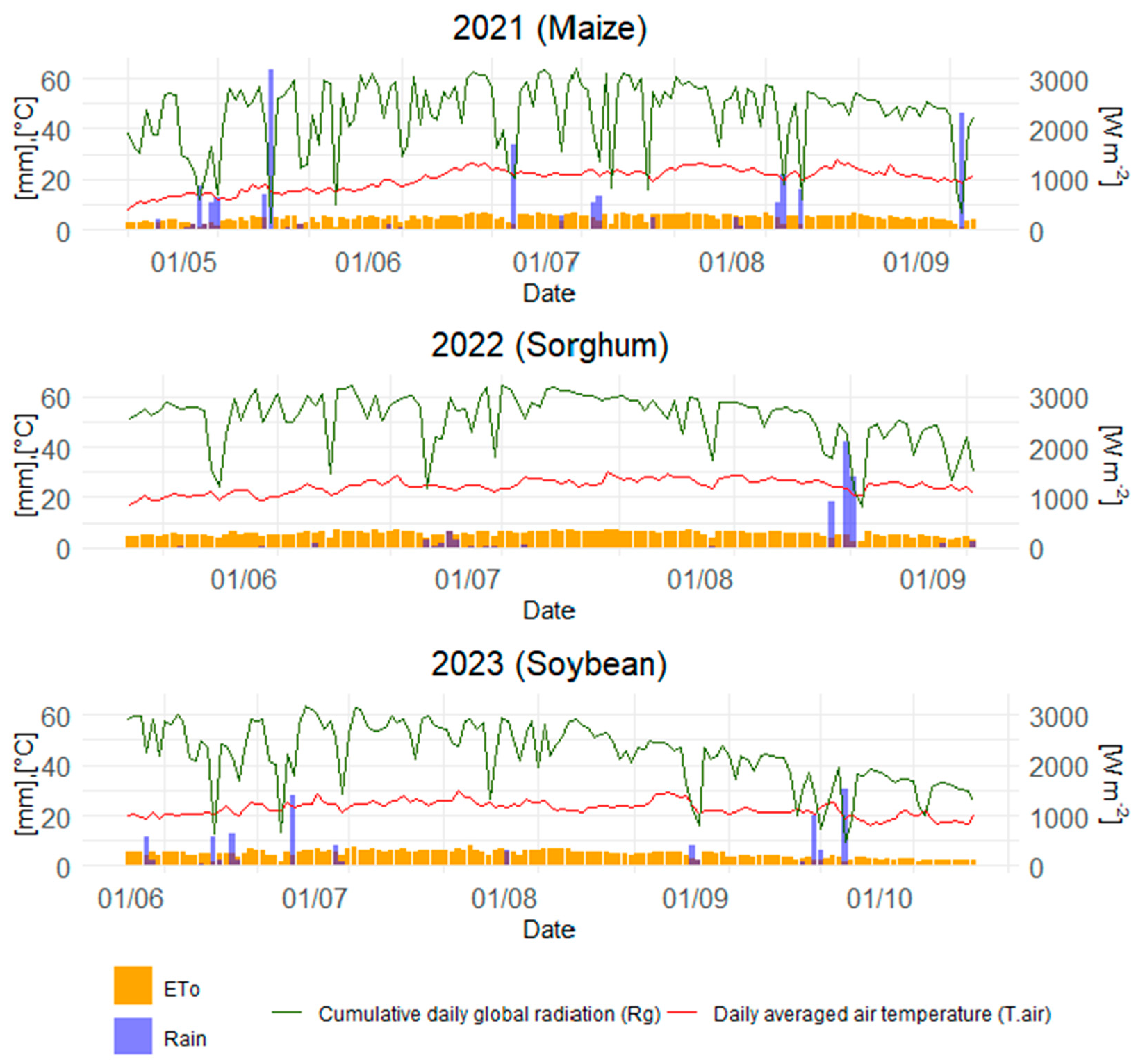
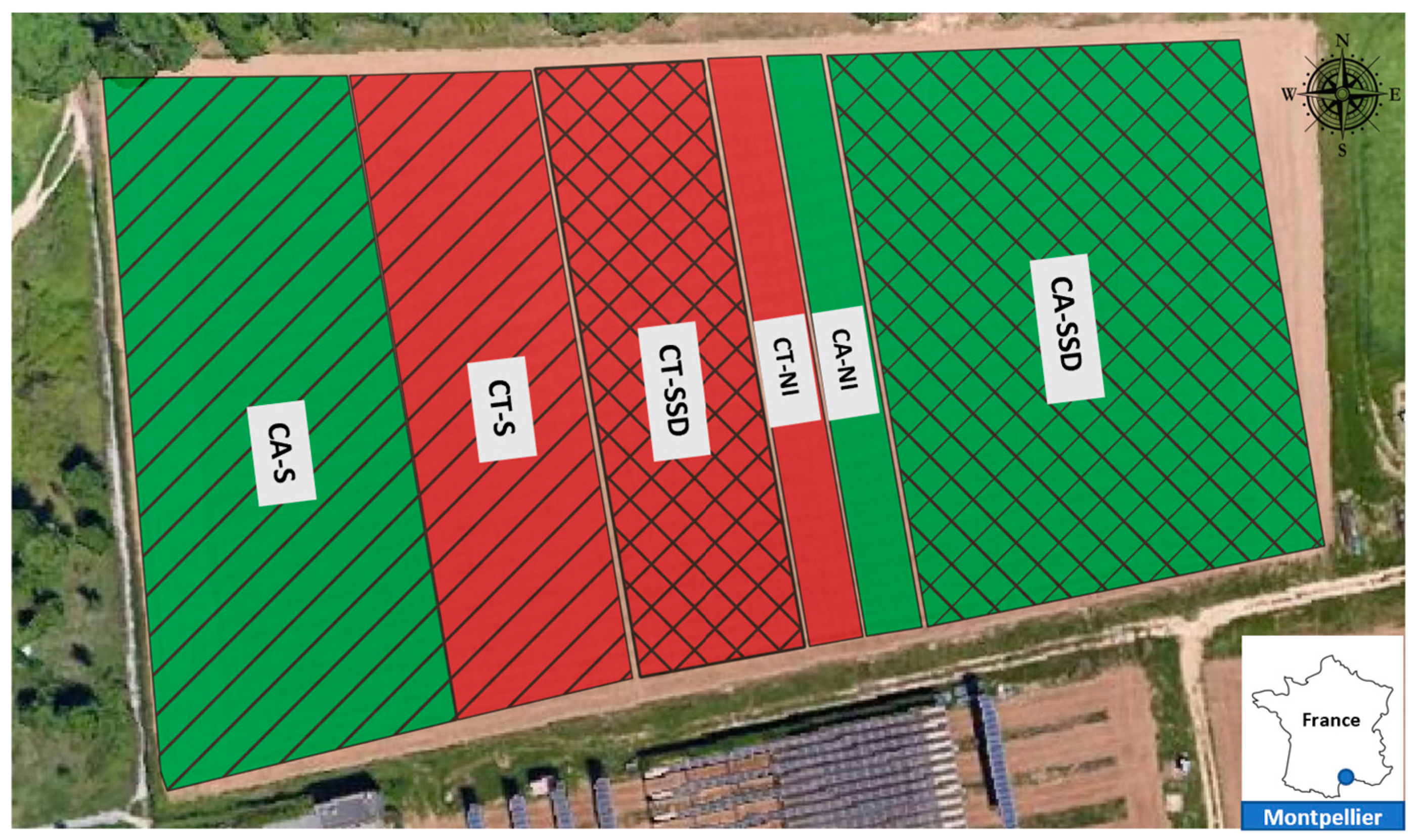
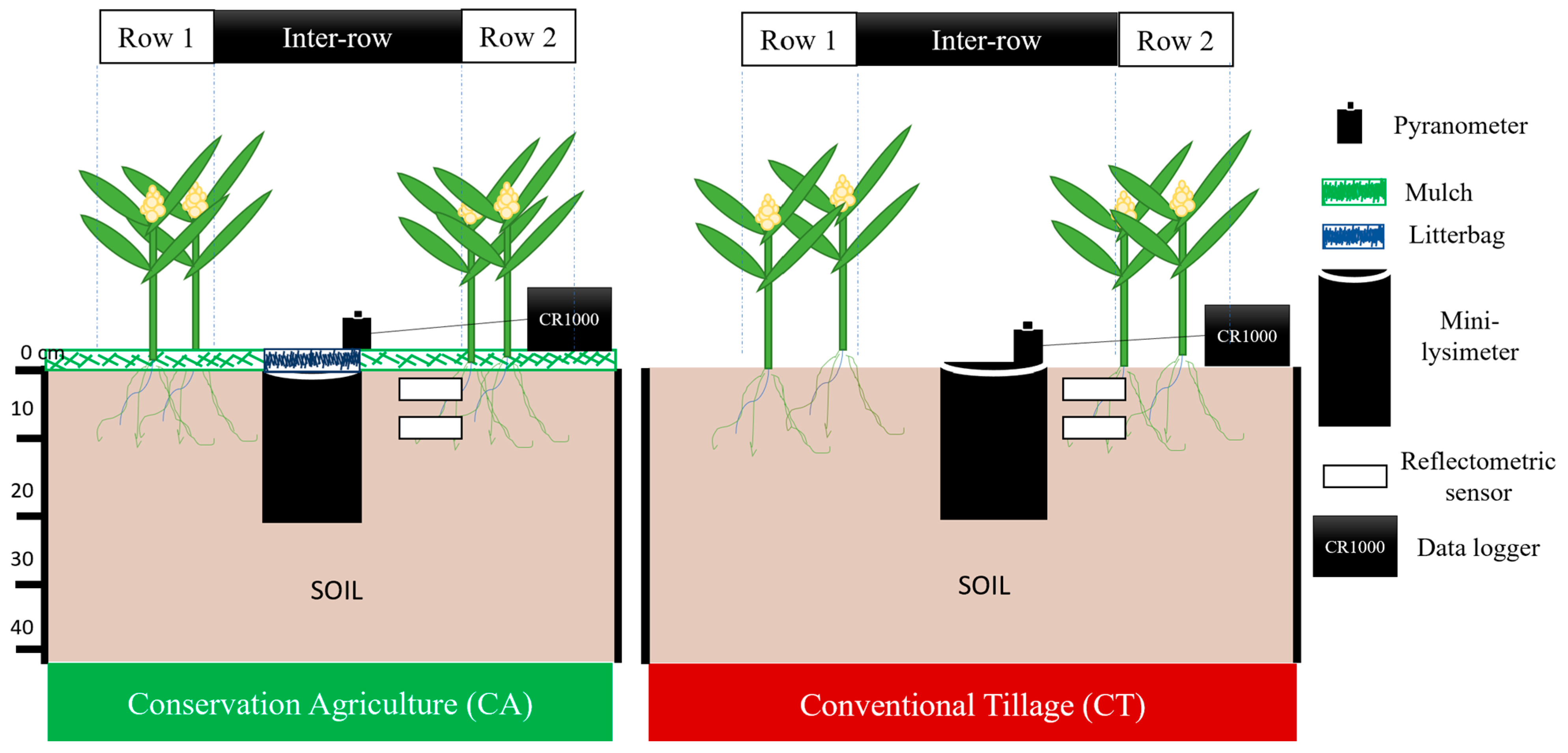

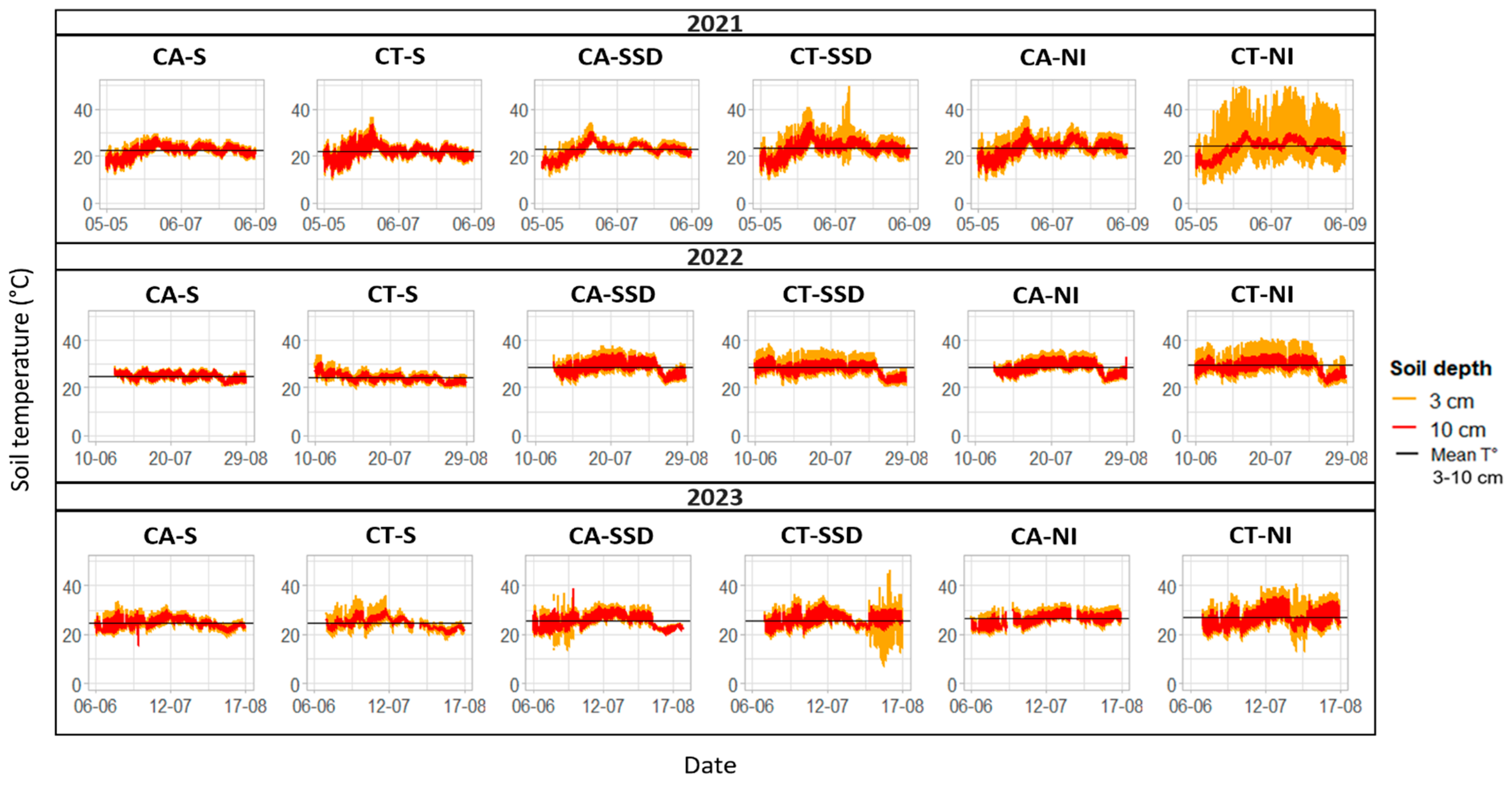

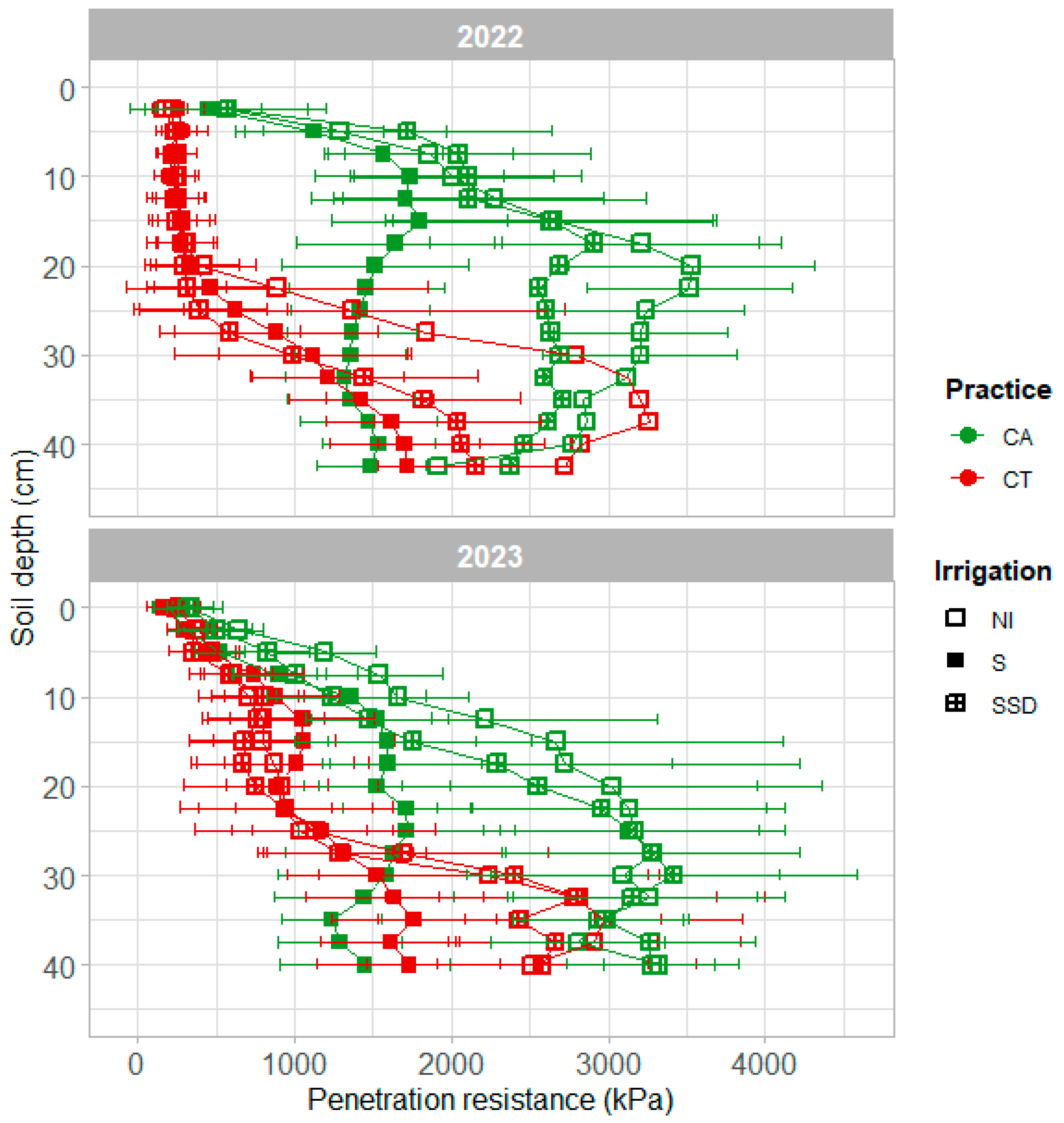
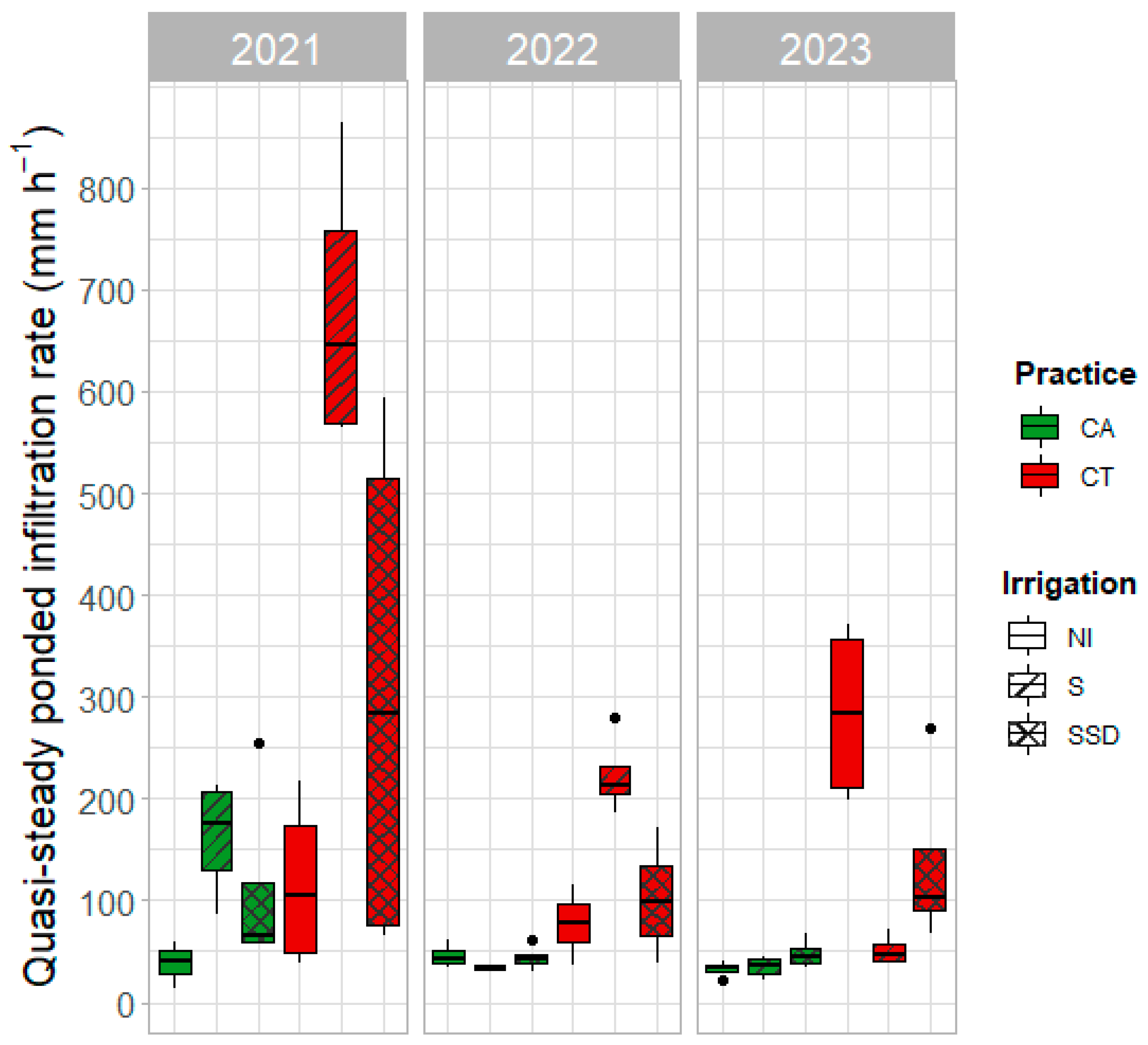
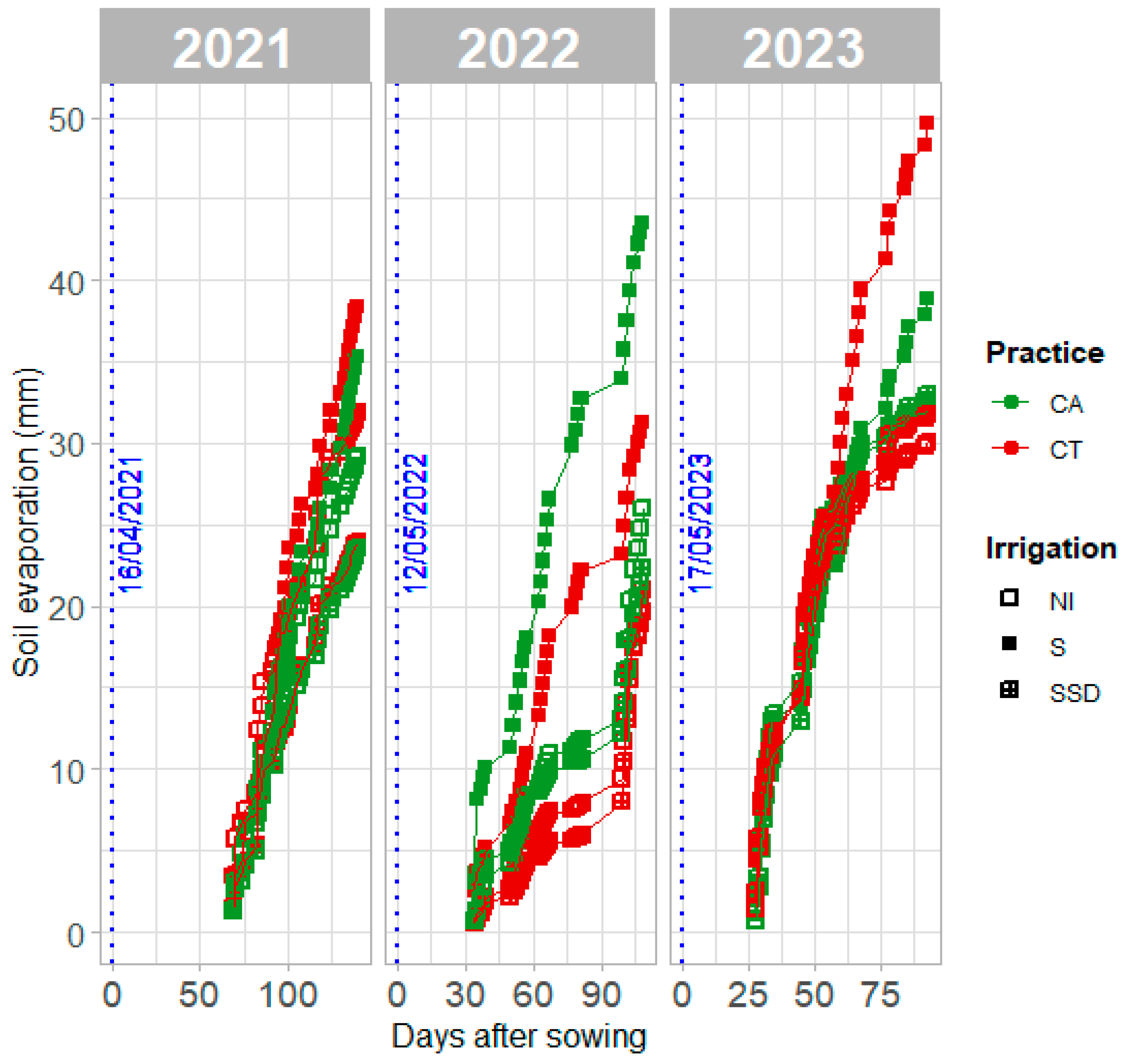
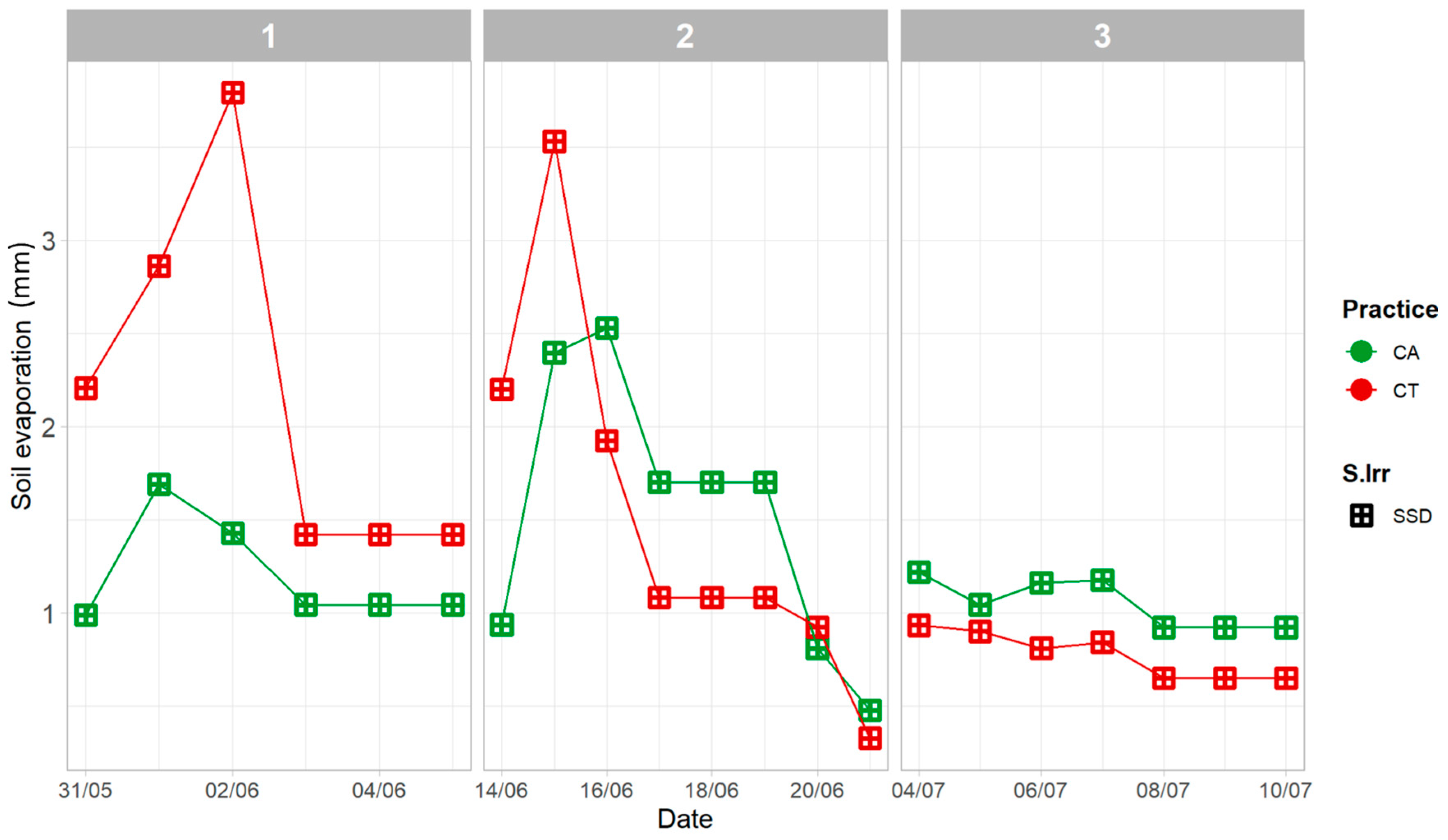

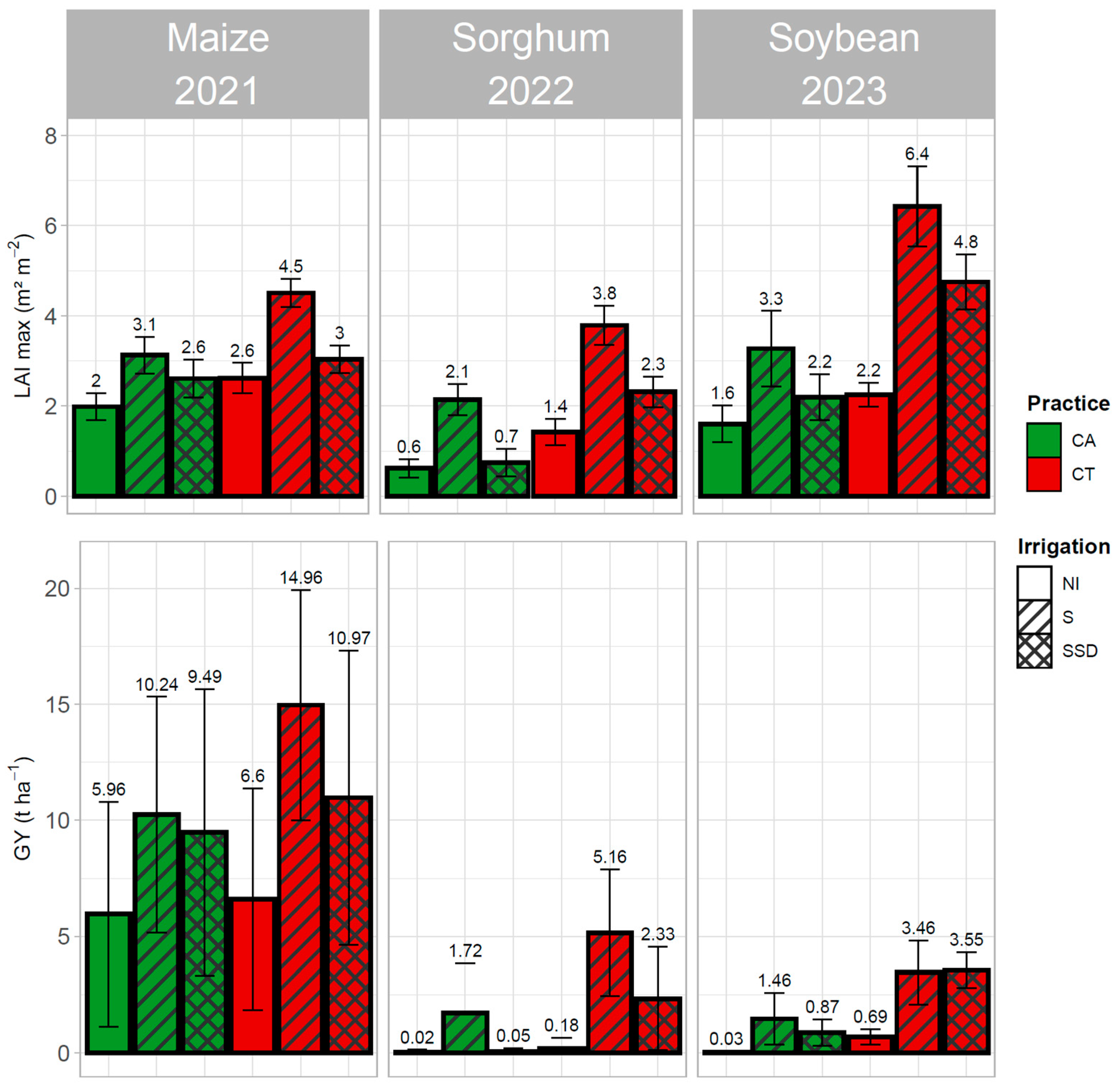
| Practice | 2021 | 2022 | 2023 |
|---|---|---|---|
| Winter cover crop sown in CA | Faba bean | Mixture of mustard, phacelia and vetch | Mixture of faba bean and oat |
| Sowing date of winter cover crop | 12 September 2020 | 17 November 2021 | 20 September 2022 |
| Dry biomass of winter cover crop in CA | 3 t·ha−1 | 6 t·ha−1 | 6 t·ha−1 |
| Main crop: variety | Maize: IXABEL | Sorghum: HUGGO | Soybean: SPEEDA |
| Date of tillage in CT with plow Huard (30 cm) | 10 October 2020 23 November 2021 | 22 October 2022 | 20 January 2024 |
| Date of ground fertilizer application for CA and CT | 18 March 2021 (K: 120U) 09 April 2021 (N: 180U) | 11 April 2022 (N: 90U, P: 70U, K: 150U) | - |
| Date of seedbed preparation in CT (rotary harrow) | 15 April 2021 | 9 May 2022 | 9 May 2023 |
| Date of winter cover crop termination in CA (farming tool used) | 15 April 2021 (FACA roller) | 11 May 2022 (Roll’ N’ Sem ROLLS) | 17 May 2023 (Roll’ N’ Sem ROLLS) |
| Date of main crop sowing (direct seeding in CA) | 16 April 2021 | 12 May 2022 | 17 May 2023 |
| Seeding density of main crop | 8.3 seeds·m−2 | 31.5 seeds·m−2 | 33 seeds·m−2 |
| Date and type of weed control | 27 May 2021: Hoeing on the CT plots 1 June 2021: Pass of the flail mower on CA plots 4 June 2021: Selective herbicide application on CA plots | 10 May 2022: Herbicide application on CA plots 11 May 2022: Pass of “Roll N Sem” roller on CA plots 30 May 2022: Hoeing on the CT plots | 27 June 2023: Hoeing on the CT plots |
| Date of main crop harvest | 6 September 2021 | 3 September 2022 | 12 October 2023 |
| Duration of main crop cycle (days) | 143 | 113 | 139 |
| Measurement | 2021 | 2022 | 2023 |
|---|---|---|---|
| Bulk density | April 22nd | June 15th | September 8th |
| Soil temperature | From May 5th to September 3rd | From June 10th to August 29th | From June 6th to October 19th |
| Soil penetration resistance | April 22nd | September 27th | December 7th |
| Quasi-steady ponded infiltration rate | May 6th | May 30th | June 28th |
| Soil evaporation | From June 21st to September 3rd | From June 14th to August 30th | From May 26th to August 18th |
| Leaf area index (LAI) | From June 10th to September 2nd | From July 1st to August 18th | From June 20th to September 18th |
| Grain yield and water productivity | September 6th | September 3rd | October 12th |
| 2021 (Maize) | 2022 (Sorghum) | 2023 (Soybean) | ||||||||||
|---|---|---|---|---|---|---|---|---|---|---|---|---|
| Treatment | I (m3·ha−1) | R + I (m3·ha−1) | TWP (kg·m−3) | IWP (kg·m−3) | I (m3·ha−1) | R + I (m3·ha−1) | TWP (kg·m−3) | IWP (kg·m−3) | I (m3·ha−1) | R + I (m3·ha−1) | TWP (kg·m−3) | IWP (kg·m−3) |
| CA-S | 2100 | 6000 | 1.70 | 2.02 | 2400 | 3550 | 0.48 | 0.71 | 3000 | 4570 | 0.32 | 0.48 |
| CA-SSD | 2500 | 6400 | 1.48 | 1.41 | 2600 | 3750 | 0.01 | 0.01 | 2700 | 3870 | 0.20 | 0.31 |
| CA-NI | - | 3900 | 1.53 | - | - | 1150 | 0.02 | - | - | 1570 | 0.02 | - |
| CT-S | 2400 | 6300 | 2.37 | 3.48 | 2600 | 3750 | 1.38 | 1.92 | 2700 | 4270 | 0.81 | 1.02 |
| CT-SSD | 2500 | 6400 | 1.71 | 1.75 | 2600 | 3750 | 0.62 | 0.83 | 2700 | 4270 | 0.83 | 1.06 |
| CT-NI | - | 3900 | 1.69 | - | - | 1150 | 0.16 | - | - | 1570 | 0.44 | - |
| 2021 | 2022 | 2023 | |||||||
|---|---|---|---|---|---|---|---|---|---|
| Variable | Practice (CA, CT) | Irrigation System (S, SSD, NI) | Practice and Irrigation System | Practice (CA, CT) | Irrigation System (S, SSD, NI) | Practice and Irrigation System | Practice (CA, CT) | Irrigation System (S, SSD, NI) | Practice and Irrigation System |
| LAI | * | *** | ns | *** | ** | ns | ns | ns | ns |
| Grain Yield | *** | *** | * | *** | *** | *** | *** | *** | * |
| Bulk density | ns | ns | ns | ns | ** | ns | ns | ns | ns |
| Soil temperature (mean between 3 and 10 cm depth) | * | *** | *** | * | *** | *** | *** | *** | ** |
| Soil penetration resistance | - | - | - | *** | * | ns | *** | ns | ns |
| Quasi-steady ponded infiltration | * | * | * | *** | ns | *** | *** | ns | ** |
| Soil evaporation | ns | *** | ns | * | *** | ns | ns | *** | ns |
Disclaimer/Publisher’s Note: The statements, opinions and data contained in all publications are solely those of the individual author(s) and contributor(s) and not of MDPI and/or the editor(s). MDPI and/or the editor(s) disclaim responsibility for any injury to people or property resulting from any ideas, methods, instructions or products referred to in the content. |
© 2025 by the authors. Licensee MDPI, Basel, Switzerland. This article is an open access article distributed under the terms and conditions of the Creative Commons Attribution (CC BY) license (https://creativecommons.org/licenses/by/4.0/).
Share and Cite
Dominguez-Bohorquez, J.D.; Wittling, C.; Cheviron, B.; Bouarfa, S.; Urruty, N.; Lopez, J.-M.; Dejean, C. Early-Stage Impacts of Irrigated Conservation Agriculture on Soil Physical Properties and Crop Performance in a French Mediterranean System. Agronomy 2025, 15, 299. https://doi.org/10.3390/agronomy15020299
Dominguez-Bohorquez JD, Wittling C, Cheviron B, Bouarfa S, Urruty N, Lopez J-M, Dejean C. Early-Stage Impacts of Irrigated Conservation Agriculture on Soil Physical Properties and Crop Performance in a French Mediterranean System. Agronomy. 2025; 15(2):299. https://doi.org/10.3390/agronomy15020299
Chicago/Turabian StyleDominguez-Bohorquez, Juan David, Claire Wittling, Bruno Cheviron, Sami Bouarfa, Nicolas Urruty, Jean-Marie Lopez, and Cyril Dejean. 2025. "Early-Stage Impacts of Irrigated Conservation Agriculture on Soil Physical Properties and Crop Performance in a French Mediterranean System" Agronomy 15, no. 2: 299. https://doi.org/10.3390/agronomy15020299
APA StyleDominguez-Bohorquez, J. D., Wittling, C., Cheviron, B., Bouarfa, S., Urruty, N., Lopez, J.-M., & Dejean, C. (2025). Early-Stage Impacts of Irrigated Conservation Agriculture on Soil Physical Properties and Crop Performance in a French Mediterranean System. Agronomy, 15(2), 299. https://doi.org/10.3390/agronomy15020299







